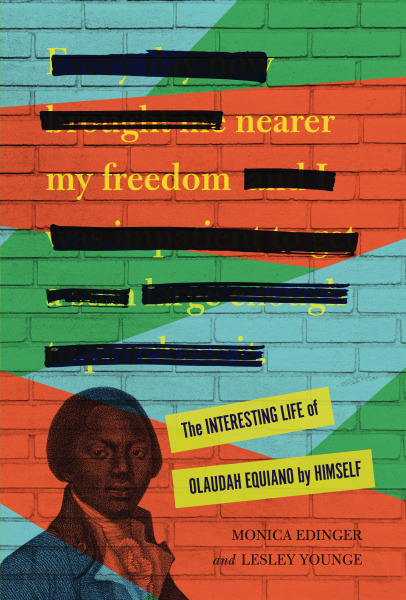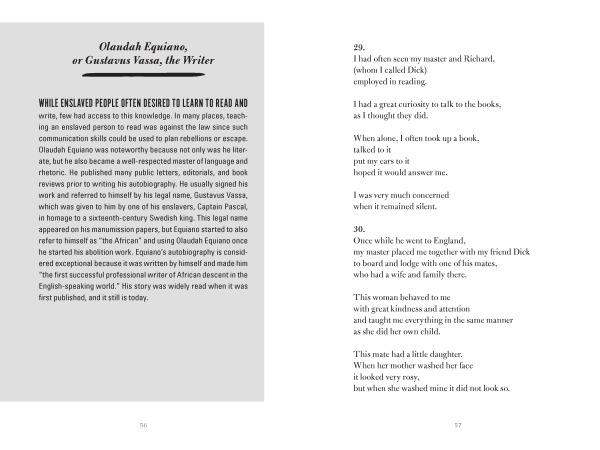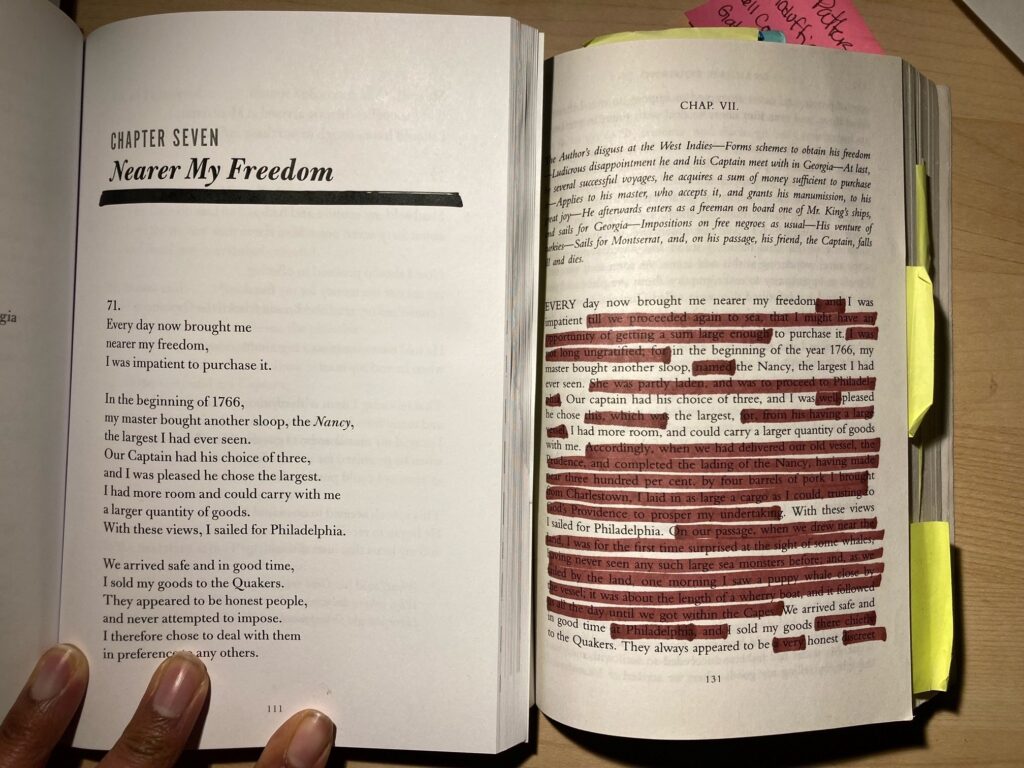Why Teens Should Read Hard History, a guest post by Lesley Younge

Something I learned from my mentor, Monica Edinger, the coauthor of Nearer My Freedom, is to lean into teaching hard history. We met as fourth grade teachers at The Dalton School in New York City. Our social studies curriculum was a year long study of immigration and the development of diversity in America, which included a unit on the Transatlantic Slave Trade. A challenging topic to cover with any developmental age, we focused on stories of resistance and learned about the captured Mende of the Amistad who fought back physically, Ona Judge who ran away from George Washington, and the Gullah of the Sea Islands who preserved their West African customs and culture. We always started the unit by establishing a respectful understanding of the rich cultures from which people were torn away. This was where I first met Olaudah Equiano. His 1789 autobiography, The Interesting Narrative of the Life of Olaudah Equiano, Or Gustavus Vassa, The African was retold by Ann Cameron in The Kidnapped Prince; our culminating project was creating found verse about the experiences of captured and enslaved Africans from that elementary aged adaptation. We allowed literature and poetry to guide us through a very difficult period of history. On the other side of learning about the cruelty of the slave trade was deeper empathy for those impacted and greater understanding of how human choices shape the world.

It was the power of Equiano’s story and that classroom poetry that inspired us to create Nearer My Freedom, a found verse novel remix sprinkled with contextual essays that provide key background information for today’s reader. We thought that found verse would resonate with young adults by stripping away the density of 18th century prose and highlighting the lyrical nature of Equiano’s dynamic abolitionist rhetoric. Olaudah Equiano’s story remains important because it reminds us there were eyewitnesses to the Transatlantic Slave Trade: the millions of captured Africans as well as their enslavers and the sailors who manned the ships for hundreds of years while the trade went on. It is impossible to deny what he says he lived through or to pass it off as exaggeration. Presenting his story to a new generation is an effort to push back against the current assault on learning the truth about slavery: that the global community, including the United States, is still reeling from its economic, political, cultural, and geographic effects and that there is much to reconcile before we truly heal.
ADVERTISEMENT
ADVERTISEMENT

At the time that he wrote, Olaudah Equiano was on the front lines of a growing abolitionist movement in England, one that was interracial and rooted in both moral and religious imperatives. Through his work, he became part of a long line of historical figures who fought for just treatment and human rights. Equiano’s story is well known and discussed in many adult books about his life, the Atlantic slave trade, the growth of the British empire, the abolition movement in England, 18th century sailing, and the Caribbean. He is part of the exhibit on the slave trade at the Smithsonian National Museum of African American History and Culture. Recently the DuSable museum in Chicago commissioned a film experience about Equiano’s childhood that they presented through social media. This body of work was incredibly helpful as we sought to shed light on more obscure references and events that may be well known across the Atlantic but are less studied in American schools. We are thrilled that Nearer My Freedom fits perfectly into the gap in materials for teens about this extraordinary figure and his seminal text. Through our book, teens will come to know Olaudah Equiano’s world and his words.

Reading hard history builds empathy and intercultural competence. It allows young people to understand new and different perspectives. We hope Nearer My Freedom appeals to those who know a lot about slavery and those who are just beginning to peel back the layers on this complex topic. Reading hard history also prepares young people to connect the dots between historical events and current social issues so they might take informed action. One of the major themes of Equiano’s story is a determined quest for liberation that continues long after he purchases his freedom. Even after he was no longer enslaved, he went through many trials and tribulations that made him question how much freedom he really had as long as slavery still existed and he could be reenslaved at any moment. Ultimately, he came to recognize that, as Dr. Maya Angelou said, “no one of us can be free until everybody is free”. Thus, he was driven to join the abolition movement. That need to build community and work for the greater good is something I think a lot of teens grapple with. Hopefully they will find inspiration in the life and message of Olaudah Equiano.

Our young people are trying to understand the world they are inheriting, and they deserve a full accounting. As book bans and school board fights fill the news, libraries, and the librarians that make them the vibrant community spaces they are, become even more important. You are on the front lines as guardians of truth, information, and access. But you are not alone. Authors like myself and Monica stand alongside you in solidarity. The events of centuries ago are like the geological layers of a canyon telling us how our current landscape has evolved. We cannot and we should not pretend they don’t exist. Monica and I created Nearer My Freedom for kids who want to know about the past and how it has shaped our present. We hope it gives librarians, parents, teachers, and young people themselves the support they need to teach and learn Olaudah Equiano’s story and other stories like it. The people who came before us lived through very difficult and violent times, yet they were resilient and collaborative in seeking solutions to immense problems. Reading hard history does not automatically lead to despair. It is a path to hope too.
Meet the authors

Lesley Younge is a writer, mother, and educator currently teaching middle school English and math in Washington D.C. Originally from Southern California, she graduated from New York University and Bank Street College of Education. Lesley has developed curriculum with a wide range of organizations such as the Central Park Conservancy, the Museum of Art and Design, the Montgomery County Lynching Memorial Project, the Zinn Education Project, and the National Museum of Asian Art. Now she is the author of two books for young people, Nearer My Freedom and A-Train Allen. A fellow of the Hurston/Wright Foundation and Anaphora Literary Arts, Lesley blogs regularly at teacherlesley.com.
Twitter @TeacherLesley
Instagram @teacher.lesley
LinkedIn https://www.linkedin.com/in/teacherlesley
Lesley Younge’s Website: https://teacherlesley.com/
Monica Edinger is a retired classroom teacher and the author of the children’s book Africa Is My Home: A Child of the Amistad (Candlewick 2013), which won the 2014 Children’s Africana Book Award. Monica is a children’s book world influencer with a large following on her blog, educating alice. She has contributed reviews and articles for the Horn Magazine and The New York Times, served on several award committees, and published numerous books and articles for educators. She is based in New York.
Twitter @medinger
Instagram @monicaedinger
Facebook @monica.edinger
Educating Alice: https://medinger.wordpress.com/
About Nearer My Freedom: The Interesting Life of Olaudah Equiano by Himself
Millions of Africans were enslaved during the transatlantic slave trade, but few recorded their personal experiences. Olaudah Equiano’s The Interesting Narrative of the Life of Olaudah Equiano is perhaps the most well known of the autobiographies that exist. Using this narrative as a primary source text, authors Monica Edinger and Lesley Younge share Equiano’s life story in “found verse,” supplemented with annotations to give readers historical context. This poetic approach provides interesting analysis and synthesis, helping readers to better understand the original text. Follow Equiano from his life in Africa as a child to his enslavement at a young age, his travels across the Atlantic Ocean and Mediterranean Sea, his liberation, and his life as a free man.
ISBN-13: 9781728464077
Publisher: Lerner Publishing Group
Publication date: 03/07/2023
Age Range: 12+
Filed under: Guest Post
About Amanda MacGregor
Amanda MacGregor works in an elementary library, loves dogs, and can be found on Twitter @CiteSomething.
ADVERTISEMENT
ADVERTISEMENT
SLJ Blog Network
Endangered Series #30: Nancy Drew
Research and Wishes: A Q&A with Nedda Lewers About Daughters of the Lamp
Cat Out of Water | Review
ADVERTISEMENT







